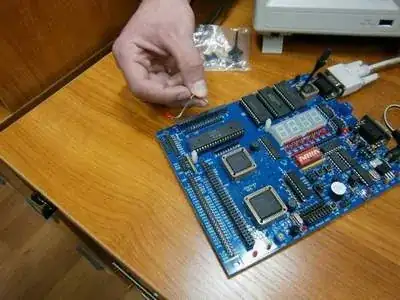Here is a snapshot of the clock and data signals of HC11 obtained in this way on the scope screen:

As you (Brian Drummond) supposed, a small program (simply reading/writing from/to a memory cell) is looped. The first probe should be connected to CS, the second - to (some wire of) the buses... and the oscilloscope should be synchronised with CS (the "trick":) But I could not find this picture and showed a snapshot where the first shape represents the clock (2 MHz), the second - a signal of the data bus... and the oscilloscope is externally synchronised with CS. Then, by moving the second probe, we can investigate all the interesting signals on the buses...
Now let's see how we can realize this idea only with a LED... Actually, it has long been used in dynamic 7-segment LED indicators. We can control a LED from the side of the anode keeping its cathode at the steady ground; conversely, we can control it from the side of the cathode keeping its anode at the steady Vcc; finally, we can control it simultaneously from both the sides (of the anode and cathode) simply realizing an AND function without any additional circuits. Thus the signal applied from the side of the cathode can serve as SELECT (CS of the observed device) in respect to the INPUT bus signal of interest (e.g., A15) applied from the side of the anode. So, every time when CS is active (low), and the observed bus signal (A15) is high, the LED will flash... and if we repeat it quickly enough, we will have the illusion the LED lights up continuously (the Edison's cinematograph idea or the stroboscopic idea).

So, the 'trick' is extremely simple - just connect a LED (of course, via a resistor) between these two points (the cathode to CS and the anode to the bus line)...

... and loop a simple program (e.g., a single LDA or STA instruction followed by BRA).
It is interesting that this humble stroboscopic logic probe is better (for this purpose) than the oscilloscope. There we have to take into account the value of the observed signal only within the time interval where CS is active while here the LED indicates the signal only in this interval.
Furthermore, we can connect multiple diodes to observe simultaneously all bus lines (hoping that CS can endure the sum of the LED currents).
It seems incredibly but we can observe this HF pulse signals even with an ordinary DC voltmeter connected through a diode between CS and the point of interest. While, in the case of the LED, our inert vision integrates the pulses, here the inert voltmeter integrates them. In contrast to the LED probe, this indicator has the advantage that it does not consume any current from the buses.



